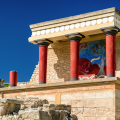LARGE PALAIS
Go there and contact
Palace in Knossos, the most important power center of the Minoan period.
The palace of Knossos, the most important centre of power in the Minoan period, is a vast, unfortified complex organized around a large central rectangular courtyard. The terraced roofs were supported by colonnades that were intended to be median in order to impose side doors. Lighting was provided by numerous windows and interior courtyards that functioned as skylights. The hydraulic system was state-of-the-art: a network of sewers drained the water from torrential rains as well as waste water. Water from the springs reached the palace through a series of baths or water stations. As there was no fixed fireplace, braziers were used when necessary. The palace was built on an artificial eminence, overlooking the valley of Kairatos. The unevenness of the terrain was fully utilised by the architect of the time, with two plans: the eastern wing is at a lower level than the central courtyard and the rest of the building. Today, the site is entered through the western courtyard.
The Procession Corridor owes its name to the frescoes that adorned its walls. Hundreds of figures of musicians, offering bearers, priests, and priestesses made up the double procession that converged on a woman, probably a goddess, priestess, or queen of the palace. The corridor leads to the propylaea, where gigantic double horns, similar to those of bulls, stand as symbols of Minoan religion. From here, a small staircase leads to the central courtyard, while another leads to the upper floor.
Itis in the courtyard that you will see the identically reconstructed stone throne room and its adjacent vestibule, through which the throne room can be observed. In this vestibule, Evans had placed the reproduction of the wooden throne, where he encountered a charred remnant of wood. It is from here that you can see the beautiful frescoes of wingless griffins that adorn the walls. These are close reproductions of the original frescoes which are now kept in the Archaeological Museum of Heraklion. In the center of the room, the stone basin was discovered in the vicinity by archaeologists. While Evans had imagined that the stone throne was that of King Minos (and perhaps the oldest throne in Europe), other archaeologists saw it as the throne of a priestess. In front of the stone throne, a large basin accessible by a few steps was probably used for purification before the ceremonies.
Above it were the ceremonial rooms, accessible by a small staircase of eighteen steps. At the bottom of the staircase is the main sanctuary of the palace, which consists of three important rooms: the vestibule of the pillared crypts, a room containing a huge jar, and the sanctuary's treasure chamber. It was here that valuable objects were discovered, such as the snake goddesses, now in the Archaeological Museum of Heraklion, and the clay tablets containing inscriptions in Linear B. In the western part of the building were built vast stores where the harvests and the wealth of the minos were stored in huge jars, pithoi.
On the other side of the court, in the eastern part, were the royal apartments. At the entrance to these, above the door, you will find the beautiful fresco of the dolphins, the original of which is also kept in the Heraklion Museum. You will notice that the queen's apartments were equipped with water drainage systems, made of baked clay pipes. This is a fine example of the irrigation system used at Knossos, reflecting the technical prowess of the Minoan civilization.
Moving northwards, you will come to the chess corridor, and then to other stores where other products were stored. The northern buildings were probably used as living quarters for the court and servants. In the northwestern part is the theater, separated from the palace building, which Homer mentions in two verses in theIliad (18, 591-2): "... the dancing place that once, in the vast Knossos, the art of Daedalus built for Ariadne of the beautiful braids"!
You will notice the real maze of the palace which deserves its name of labyrinth... But is the palace of Knossos, as the British archaeologist Evans thought, the palace of King Minos? If Evans had imagined discovering the palace of King Minos when he undertook the excavations of Knossos, nothing fully confirms it. We still wonder today if the palace of Knossos and its incredible maze of rooms had indeed inspired the famous myth of the Minotaur.
The first excavations on the site of Knossos were undertaken in 1878 by the Cretan Minos Kalokairinos, a wealthy merchant and inveterate archaeology enthusiast, while the island was still under Ottoman occupation. The first remains uncovered are those of the southern wing of the palace. Attempts were made by the American consul W.J. Stillman and H. Schliemann and by the French archaeologist M. Joubin. All these efforts came up against legislation that prevented the expropriation of the land. It was not until the liberation of Crete in 1898 that the site became state property and systematic excavations, undertaken by A. Evans, could take place.
Did you know? This review was written by our professional authors.
Members' reviews on LARGE PALAIS
The ratings and reviews below reflect the subjective opinions of members and not the opinion of The Little Witty.



Pour avoir une bonne idée de l'histoire.
Mis à part le prix, le site est très intéressant.